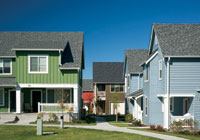A Flexible Recipe
According to the ca.gov/” target=”_blank”>California Integrated Waste Management Board, a green (or sustainable) building is a structure that is designed, built, renovated, operated, or reused in an ecological and resource-efficient manner. Such a building saves water and energy, conserves natural resources, uses salvaged materials or products made with a high recycled content, and reduces its overall impact on the environment, among other things.
“Everyone has their individual opinions about what are the necessary and essential ingredients to make a house green,” says Margo Thompson, research associate at the NAHB Research Center in Upper Marlboro, Md. “There are a lot of different ways to slice it.”
Indeed. For example: Is it better to use wood from sustainably harvested and renewable trees or a longer-lasting, man-made product that requires a fair amount of energy to manufacture? Wood siding lasts 25 years or more but requires more maintenance; the synthetic product requires less maintenance and can last 40 years.
 Or how about this: Say a builder uses bamboo flooring instead of oak. Bamboo is a rapidly renewable grass, which saves old-growth trees, but it is primarily manufactured in Asia and thus has to be shipped halfway around the world to reach U.S. builders, using fossil fuels in the process.
Or how about this: Say a builder uses bamboo flooring instead of oak. Bamboo is a rapidly renewable grass, which saves old-growth trees, but it is primarily manufactured in Asia and thus has to be shipped halfway around the world to reach U.S. builders, using fossil fuels in the process.
“All-or-nothing green is good, but it’s just not practical,” says Jennifer L. Languell, president of Fort Myers, Fla.-based Trifecta Construction Solutions, a company that helps builders realize the benefits of green building and sustainability. “You have to define what green means to you.”
Languell says she usually informs her builder clients about the components of green construction and advises them to set benchmarks they want to achieve.
Devising an Energy Strategy
A good way to begin green building is to adopt a strong energy strategy. “For almost all climate zones, energy efficiency is probably the place to start,” says Thompson. “It’s one of the easiest areas to understand.”
Imagine Homes understands the concept well, having devised an energy plan that aims to minimize callbacks while maximizing conservation.
“We’re using 100 percent blown-in cellulose insulation, and we’re doing blower-door testing and duct-blaster testing on every home to check for leakage,” Friesenhahn says. Though it might seem excessive (and expensive) to do a blower-door test on every house, the company feels it’s important. “If I know we’re testing the duct systems, I may not get that call down the road that there’s a heating or cooling problem in the house,” Friesenhahn explains. “If I can eliminate the service call, it will save me money on the back end.”
In addition, Imagine’s homes feature low-VOC (volatile organic compound) carpet, padding, and paint to improve indoor air quality; low-flow plumbing fixtures; and tankless water heaters. The result: The builder estimates that its homes are 20 percent to 30 percent more efficient than required by San Antonio’s energy codes.
